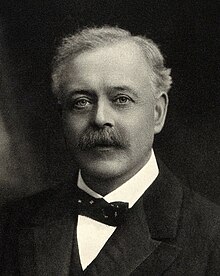Robert Jones (surgeon)
| Robert Jones | |
|---|---|
 |
|
| Born | 28 June 1857 Rhyl, Denbighshire, Wales |
| Died | 14 January 1933 Llanfechain, Montgomeryshire, Wales |
| Nationality | British |
| Fields | orthopaedic surgery |
| Known for | Jones fracture |
Sir Robert Jones, 1st Baronet, KBE, CB, TD, FRCS (28 June 1857 – 14 January 1933) was a Welsh orthopaedic surgeon who helped to establish the modern specialty of orthopaedic surgery in Britain. He was an early proponent of the use of radiography in orthopaedics, and described the eponymous Jones fracture.
Robert Jones was born in Llandudno, North Wales, and was brought up in London. His father gave up his career as an architect to take up writing, so his family became quite poor. At the age of 16 he left London to live with his uncle, Hugh Owen Thomas, in Liverpool. He learned about fracture care and the manufacture of braces from his uncle, and attended the Liverpool School of Medicine from 1873 to 1878. He continued to work with his uncle, and was subsequently appointed Honorary Assistant Surgeon to the Stanley Hospital in Liverpool in 1887. At this time, Jones and his uncle were among the few surgeons interested in the treatment of fractures, while the majority of orthopaedic surgery was aimed at correcting deformity in children and was carried out by general surgeons. He received his FRCS in 1889.
In 1888 he was appointed Surgeon-Superintendent for the construction of the Manchester Ship Canal, responsible for the injured among the 20,000 workers during the seven-year project. He organised the first comprehensive accident service in the world, dividing the 36-mile site into 3 sections, and establishing a hospital and a string of first aid posts in each section. He staffed the hospitals with medical personnel trained in fracture management. The hospitals were linked by a railway which ran the length of the canal, and Sir Robert could be contacted in Liverpool by telegraphy if his presence was required. He personally managed 3,000 cases and performed 300 operations in his own hospital. This position enabled him to learn new techniques and improve the standard of fracture management.
...
Wikipedia
